Personalization
 It wasn’t long ago, no more than 10 to 15 years, when a family walked into a funeral home that the funeral director knew exactly what they wanted. Consequently for many each funeral seemed to be a carbon copy of the previous one. Today that is not the case. Because of changes in funeral services and consumer attitudes, funeral directors have no idea what to expect when a family walks through the door. Emerging trends such as cremation, preplanning, alternative services and innovative merchandising techniques and products, combined with consumers demand for quality service and value has caused funeral directors to refocus on value-added services rather than simply providing a casket and facility. One way in which funeral directors are accomplishing this is by assisting families in planning a meaningful service. In his booklet entitled “Planning a Meaningful Cremation Funeral,” well known author on the subject of grief, Doug Manning, states, “A Funeral should be unique to the person being honored.” Personalizing a funeral service can be a very rewarding and fulfilling experience for family members. It focuses those who participate, solely on the person whose life they wish to celebrate and honour and in so doing begin the healing process. There are many ways in which a funeral service can be personalized. The following are but a few examples.
It wasn’t long ago, no more than 10 to 15 years, when a family walked into a funeral home that the funeral director knew exactly what they wanted. Consequently for many each funeral seemed to be a carbon copy of the previous one. Today that is not the case. Because of changes in funeral services and consumer attitudes, funeral directors have no idea what to expect when a family walks through the door. Emerging trends such as cremation, preplanning, alternative services and innovative merchandising techniques and products, combined with consumers demand for quality service and value has caused funeral directors to refocus on value-added services rather than simply providing a casket and facility. One way in which funeral directors are accomplishing this is by assisting families in planning a meaningful service. In his booklet entitled “Planning a Meaningful Cremation Funeral,” well known author on the subject of grief, Doug Manning, states, “A Funeral should be unique to the person being honored.” Personalizing a funeral service can be a very rewarding and fulfilling experience for family members. It focuses those who participate, solely on the person whose life they wish to celebrate and honour and in so doing begin the healing process. There are many ways in which a funeral service can be personalized. The following are but a few examples.
Pictures
One of the most popular ways to personalize a funeral service is through the use of photographs. These may be displayed individually or placed in an album. Many funeral homes provide memory boards, where photos can be mounted and displayed, or easels, which can accommodate larger pictures or portraits. There are no restrictions to the types of photos that one would display. For example, you may wish to show pictures of the family, children or grandchildren, wedding or vacation photos or a single framed portrait of your loved one. Pictures help rekindle happy memories or may stimulate others to share a story or laugh during the visitation period. Some families place photographs in the casket with their loved one, as a symbol of their love. There are caskets available with memory drawers designed to hold pictures and other personal items. Young children and grandchildren are also encouraged to draw or colour pictures. For the older children, writing a letter to grandma or grandpa is another way to share ones personal thoughts and memories.
Memorabilia
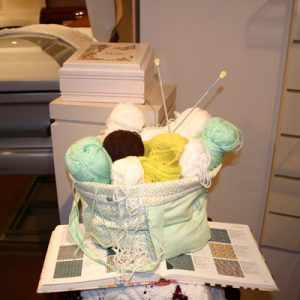 In addition to pictures, there are many other items or memorabilia that could be brought along to the funeral home to personalize the service. Two good examples of how this has been done come to mind. In both cases cremation had taken place and an urn was present during the visitation period. To honour the life of a sea captain, the family decorated the urn with items that symbolized his life on the sea. These included his journal, captain’s hat, epaulets and buttons from his uniform, beach rocks and even a piece of driftwood, all of which were lovingly placed around the urn. Behind this display hung a beautiful floral arrangement in the shape of an anchor. Anyone who came to visit the family had to be moved by this compelling tribute. A second family used personal items from their mother’s home to recreate what she loved to do each day, which was to rock in her rocking chair. They actually brought her rocker and mat to the funeral home and placed it beside the urn. For anyone who knew her, the sight of the rocking chair would surely bring back fond memories. To honour war veterans many families will display the veteran’s medals or drape a flag on the foot of the casket. Fraternal organizations will remember a departed sister or brother by displaying their group’s sash or apron. Books and poems, painting and sculptures and various awards are also displayed to recognize the accomplishments and contributions of the deceased.
In addition to pictures, there are many other items or memorabilia that could be brought along to the funeral home to personalize the service. Two good examples of how this has been done come to mind. In both cases cremation had taken place and an urn was present during the visitation period. To honour the life of a sea captain, the family decorated the urn with items that symbolized his life on the sea. These included his journal, captain’s hat, epaulets and buttons from his uniform, beach rocks and even a piece of driftwood, all of which were lovingly placed around the urn. Behind this display hung a beautiful floral arrangement in the shape of an anchor. Anyone who came to visit the family had to be moved by this compelling tribute. A second family used personal items from their mother’s home to recreate what she loved to do each day, which was to rock in her rocking chair. They actually brought her rocker and mat to the funeral home and placed it beside the urn. For anyone who knew her, the sight of the rocking chair would surely bring back fond memories. To honour war veterans many families will display the veteran’s medals or drape a flag on the foot of the casket. Fraternal organizations will remember a departed sister or brother by displaying their group’s sash or apron. Books and poems, painting and sculptures and various awards are also displayed to recognize the accomplishments and contributions of the deceased.
Funeral Ceremony
The funeral ceremony in a church or funeral home chapel, followed by the procession and graveside committal service provides a myriad of opportunities for personalization.
Music: The playing of a favorite hymn or song of the deceased’s will have special meaning for a family. For those who loved music or played a musical instrument, it would be appropriate to have a musical theme in the service. This might include the use of a choir, soloist or instrumentalist or instruments such as an organ, piano or even an accordion or bagpipes.
Tribute: Most clergy will allow a short eulogy or reflection about the deceased or pay a tribute to him or her during the homily. A eulogy can be given by a family member, best friend or clergy. This can be a very moving part of the service, forever cherished.
Liturgy: Depending on your religious affiliation the clergy or members of a parish bereavement team might wish to suggest a special scripture reading or prayer that may have been a favorite of the deceased.
Pallbearers: Friends, relatives, colleagues, fraternity, and club members are just some of the individuals who might express desire to participate in the service of a dear friend or family member. If the deceased was associated with a number of groups or organizations, the family may elect one representative from each to serve as pallbearers. Depending on the size and layout of the church or chapel (i.e aisle width), 2, 4, or 6 pallbearers are used or can be accomodated.
Honour Guard: There are a number of professions and fraternal groups that will honour a departed colleague by forming an honour guard at the entrance/exit of the church and graveside. Out of respect, representation attending the service or serving in the honour guard will dress in full uniform, where applicable. Such groups will include veterans associations, firefighters, members of the RCMP and Constabulary, military personnel, security personnel, Masons, members of the Knights of Columbus, to name a few.
Procession: Some families use the funeral procession from the church or chapel to the cemetery to pay tribute to the deceased. The route can be designed to pass by the residence or place of work. Other vehicles such as a fire truck, ambulance or horse and carriage have also been used to lead the procession or to convey the casket.
Graveside: Many groups such as veterans and Masons, in addition to forming an honour guard, will also perform a graveside ritual. Family members may also wish to participate by laying flowers on the casket, selecting a flower from the spray to keep, lowering the casket or by making some other gesture of farewell.
Every family is unique. Each will have their own emotions, values, beliefs and needs. Do not hesitate to share these with your funeral director, in order that he or she may assist you in personalizing your loved one’s funeral service.
Ideas for Personalizing
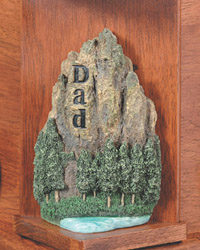
Funerals are changing. Funeral home owners, managers and directors all agree, there have been more changes in the industry over the past ten years than there have been in the previous twenty-five. The most profound change in recent years is the emphasis on personalization. Extensive consumer research has found that baby boomers, who are now arranging funerals for their parents, are moving away from traditional rituals and seeking more meaningful products and services. So personalization has become the new “buzz” word at industry conventions, marketing seminars and trade shows. With the numerous decisions and details that must be attended to and the feelings of grief making these tasks even more difficult, how does a family go about personalizing the funeral of a loved one?
Elements of Service
One way of personalizing a funeral is to incorporate the unique qualities and personality of the deceased into the various elements of the service. These may include the visitation, ceremony at the church or chapel, procession or committal service.
During the funeral planning process, consider the deceased’s hobbies, accomplishments, passions or activities that characterize his or her unique life.
Displaying the deceased’s personal possessions, memorabilia or articles used in a hobby or pastime is becoming a very popular way of personalizing the visitation period. The following examples illustrate some of the wonderful things families have done to remember and honour their loved ones.
Theme Funerals
Theme funerals are a more comprehensive focus on aspect of the deceased’s life. Families are increasingly choosing to celebrate their loved one’s lives through lifestyle displays.
Visit our Theme Funerals section, to learn more.
Eulogy
The eulogy can be the most personal and memorable part of a funeral service. A close friend, family member of clergy, may deliver it. Sometimes several people may be asked to share their memories.
Visit our Eulogies section, to learn more.
Obituary
Write a personalized obituary or expand the funeral notice to include information about the deceased.
Clothing
Choose clothing for the deceased to reflect his or her life, interests or career. The clothing need not be formal.
Flowers
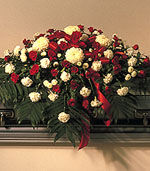 Personalize the casket spray by incorporating special items into the floral pattern such as stuffed animals, emblems, ribbons, pictures, et cetera. Bring in freshly cut flowers from your own garden. Choose the type and colour of flowers the deceased liked.
Personalize the casket spray by incorporating special items into the floral pattern such as stuffed animals, emblems, ribbons, pictures, et cetera. Bring in freshly cut flowers from your own garden. Choose the type and colour of flowers the deceased liked.
Visit our Flowers & the Grieving Process section, to learn more.
Children
Ask children or grandchildren to write a letter or draw a picture to be placed in the casket. Older children can serve as pallbearers, while younger children can serve as bearers carrying military medals, hat, et cetera.
Music
If the deceased enjoyed music, play it during the visitation period, at graveside or during the reception after the service. Select special hymns or musical instruments to be sung or played during the church or chapel service. All types of music are acceptable.
Products
 Personalize a casket or urn. There are many features available, including cap panels and distinctive hand-painted corners for caskets with outdoor, spiritual, military or family themes. Customized engraving on caskets and urn is another feature offered. Most urns may be personalized by engraving a loved one’s name, picture or a scene that would have special meaning to the deceased.
Personalize a casket or urn. There are many features available, including cap panels and distinctive hand-painted corners for caskets with outdoor, spiritual, military or family themes. Customized engraving on caskets and urn is another feature offered. Most urns may be personalized by engraving a loved one’s name, picture or a scene that would have special meaning to the deceased.
Guest Book
Create a column in the guest book for people to jot down a memory after they sign the book.
Pallbearers
Have relatives, friends or family serve as pallbearers. If the deceased was a member of a fraternal organization, a veteran or served in the community as a firefighter, police officer or another capacity, ask fellow colleagues or members of these organization to serve as pallbearers.
Grave Markers
Create a personalized grave market by including a picture, special scene, phrase or verse that defines the deceased.
Program
Create a personalized program bulletin for the funeral service. In addition to the order of service it can include a favorite poem, picture, short tribute. Some families include a copy of the funeral notice.
Leaflet
Instead of a eulogy, you might choose to print a leaflet with a picture and tribute to be circulated during the period of visitation or funeral service.
Procession
Personalize the funeral procession from the church to graveside. Include special vehicles that may have been used by the deceased as part of his or her job or favorite activity.
Internet
The internet has added a new dimension to how a loved one can be remembered. Families can now create on-line memorial tributes in perpituity, visit virtual cemeteries or even see their grandmother’s funeral live on the net, the possibilities are endless.
Creating New Traditions
A funeral is a series of rituals and traditions that is influenced by our social, religious and cultural values and beliefs. Between the years 1946 and 1964, a population explosion produced the largest generation in the history of the world. Now in their 40’s and 50’s, the “baby boom” generation has had a significant impact on society’s values and beliefs and as such is reshaping the death care industry.
Unlike the previous generation who accepted their religious and social traditions, the baby boomers are the instruments of change. In funeral service, because of the desire for unique and individualized ceremonies, ties to tradition are weakening.
While striving to plan a more personal and meaningful funeral, increasing numbers of families are choosing alternative funeral practices. To keep pace with change and satisfy emotional needs, churches and family members are creating new funeral rituals and traditions.
The committal service
A member of the clergy traditionally conducts the committal service, which may be either public or private, at graveside. It is where the family and friends say their final good-byes. With cremation becoming more popular, particularly direct cremation where families are choosing scattering rather than burial of the cremated remains, some churches have recognized a need for a short committal service prior to the commencement of the cremation process. Locally this new ritual was introduced by the Anglican Church in the early ’90s and is now referred to by funeral directors as the “committal to flame”.
Some funeral homes have an area adjacent to their crematorium where a short committal service can be held. Families are invited by the funeral director to attend the service but are not obligated to do so. The “committal to flame” is mandatory in the Newfoundland Anglican Church’s Eastern Diocese, and an Anglican clergy must be called to conduct the service regardless of whether the family is in attendance. It is optional in the United Church and will be held at the request of the family. As yet, it is not offered by other Christian faiths.
Families wishing to attend may choose to have the remains in a closed casket placed in the retort out of sight or left in the committal area in full view of those in attendance. They must also be guided by the clergy’s preference. When placed outside the retort, family members may choose to carry out the same traditions performed at a graveside service such as placing flowers on the casket, taking them from the floral spray or touching the casket for the final time. It also allows the funeral director to perform the ritual of sprinkling sand over the casket or container when the clergy reads the actual committal.
When the casket or container is placed in the crematorium, the door is usually closed. The family will still gather in the committal area with the clergy and funeral director for prayers and support. In either case, unless otherwise requested, the crematorium is not turned on until after the family has left the premises.
Both the Anglican and United Church have written a special liturgy for this service, which includes a reference to the committal of the body to flame rather than earth.
This new ritual brings closure for family members and gives them a place to pay their final respects and say good-bye.
Variations to an already established ritual can also be made. As referenced earlier, at a graveside committal service funeral directors will sprinkle sand over the casket or urn when the clergy says “earth to earth, ashes to ashes, dust to dust.” In most cases the funeral director uses a small brass holder called a “shaker,” containing silica sand. On one occasion, just before the start of a funeral service, the deceased man’s son who carried a small bottle of sand approached a funeral director. The sand had come from his father’s birthplace, and he asked that it be used instead of the traditional shaker. The funeral director suggested that the son perform the ritual of sprinkling the special sand over his father’s casket. At the end of the service, after emptying the majority of the sand into the grave, the son kept a small portion as a symbol of the cherished memories of this father. This ritual meant a great deal to the son, but it also deeply moved those who attended the committal service. We learn rituals from others, and we share them as well.
This simple graveside ritual was seen again, on the national stage, at the tomb of the Unknown Canadian Soldier. When the casket had reached its final resting place, a representative from each province, territory and First Nation symbolically poured a small amount of soil, which came from his or her province or territory, into the open tomb.
The Chinese community also has its own ritual at graveside. Mourners pass out to all those in attendance small packages containing candy and coins. The candy represents the sweetness of life that has been lived and money symbolizes good fortune.
Chapel Services
A traditional funeral ritual, in which families are considering other opinions, is the practice of holding the funeral ceremony in a church. Many families are choosing chapels over churches whether they are located in a funeral home, resident care facility, university or some other public institution.
In 2000, of the approximately 1200 deaths that occurred in St. John’s, Mount Pearl and surrounding areas, over 300 or between 25 or 30 per cent had a chapel service. Reasons for the increasing use of chapels include a migratory population who are not affiliated with a church and would prefer the neutrality of a chapel; long term residents of nursing or seniors’ homes who become detached from their local congregations and would rather use the chapel at the resident care facility to accommodate their close friends residing in the home; or if the deceased was elderly and a low attendance was anticipated.
Of the three most prominent denominations in the area, the United Church is the most receptive to chapel services with over 50 per cent of their funerals conducted from a chapel. The Anglican Church follows this at almost 40% and the Roman Catholic Church about 15%. Other smaller Christian denominations and religious groups are also very comfortable with using a chapel.
It is tradition in the Roman Catholic Church to celebrate mass as part of the funeral liturgy. Although the Liturgy is permissible and can be lead by a lay representative, the Archbishop has prohibited a lay representative in a traditional mass. Although more Roman Catholics are choosing to hold funeral services at a chapel, many still prefer the traditional funeral liturgy with mass.
New Liturgies
In addition to the new liturgy created for the “committal to flame” ritual, churches are also responding to new challenges presented by grieving families. The Anglican Church has instituted new liturgies for the burial of a stillborn child or those who do not profess to be Christian. The Roman Catholic Church has recognized the growth of cremation and has revised their funeral and burial liturgies to accommodate the cremated remains in their church and cemeteries.
General
Baby boomers are reinventing the funeral to include unconventional eulogies and tributes, even showing videotapes of the deceased. Families want to take an active part in the funeral whether it is with the selection of the burial clothing, choosing pictures or personal effects for display or writing a note or poem to be placed in the casket. Gestures such as these become traditions for families, thereby assisting them in their time of grief and enhancing how they’re loved one’s life is remembered and celebrated.
Theme Funerals
 The trend towards personalizing a loved one’s funeral is growing. So are the many ways in which a funeral service can be personalized. As consumer research has shown, baby boomers, which are now organizing their parents’ funerals, are moving away from traditional rituals and selecting new products and services that have more meaning for them.
The trend towards personalizing a loved one’s funeral is growing. So are the many ways in which a funeral service can be personalized. As consumer research has shown, baby boomers, which are now organizing their parents’ funerals, are moving away from traditional rituals and selecting new products and services that have more meaning for them.
Because each family is unique, they each have their unique way of personalizing the special qualities of their loved one and expressing what he or she meant to them and others. It may be their favorite pastimes, hobbies or sports, service in the military, church or community or career related.
In addition to the traditional ways of personalization such as displaying photographs, including a eulogy, favorite hymns or music at the funeral or having friends, relatives or colleagues serve as pall bearers, new ways to remember and honour the deceased are emerging.
Lifestyle Display
At a recent tradeshow in Toronto, Batesville Casket Company unveiled their “Lifestyle vignettes,” or illustrative displays for use in a visitation room that focus on the life of the deceased.
Several themes were highlighted. For the avid outdoorsman the décor used was similar to that found in a typical hunting lodge or summer cabin. On a wall above the casket hung the preserved head of an antlered deer. A fishing rod, tackle and net rested next to it. A wooden, light oak casket, which matched the wall paneling of the cabin setting, was personalized with a red flannel interior, throw and pillow, and embroidered on the casket’s inside cap panel was a large fish just taking the hook. A comfortable hat and flannel shirt were hung on a coat rack beside the casket and a small scatter rug placed in front of it.
Instead of a traditional bier, the casket was placed on a wooden table, which was similar in colour to the casket. The display also includes various plants and shrubbery that an outdoorsman might encounted while hunting or fishing.
A second display was a suggested layout for a musician. Aptly named, “Cool Jazz,” the casket was placed on two loudspeakers from which background music could be heard. A drum set and other musical instruments were displayed nearby. Other ways to enhance this display would be to place cutouts in the shape of musical notes in the casket spray or lay music sheets around the visitation room.
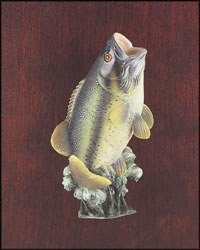 There was also a farm-themed display, which showed a casket resting on a rustic quilt, and at the foot a pair of rubber boots still muddy from use in the fields. Inside the casket a small toy tractor was placed in Batesville’s Memory Safe, a drawer designed to allow family members to deposit notes, or a loved one’s most treasured object.
There was also a farm-themed display, which showed a casket resting on a rustic quilt, and at the foot a pair of rubber boots still muddy from use in the fields. Inside the casket a small toy tractor was placed in Batesville’s Memory Safe, a drawer designed to allow family members to deposit notes, or a loved one’s most treasured object.
Other features exclusive to Batesville that families can select to personalize a casket include a variety of Life SymbolsTM casket corners. These distinctive, hand-painted corners, available on select wood and metal units, are easily attachable and removable from the exterior of the casket. Appropriate as a keepsake, these corners reflect themes like gardening, patriotism, spirituality, golfing, outdoor activities and family.
Engraving on the exterior panels of wood or metal caskets is another feature offered. Examples of the types of engraving done include a love one’s name, an insignia or crest, fraternal symbol, designs showing a hobby or professional pursuit, or a simple word like “Mother.”
Referred to by the media as “theme funerals,” Batesville lifestyle visitation displays and personalized casket features illustrate how creativity can contribute to lasting memories.
Designer Caskets
In addition to the many ways Batesville personalizes a casket, there is a company in Dallas, Texas, called Whitelight that makes customized caskets, referred to as “Art Caskets.” The exterior of these caskets are decorated with images such as angels, religious figures and AIDS awareness ribbons. There is even a casket for the golf fanatic.
Another company, Ghia Enterprises of San Francisco, offers designer caskets such as the Jerry Garcia model. Painted on the top panel of the casket is a full psychedelic portrait of the late “Grateful Dead” band member.
Although designer caskets are not the type of product that will appeal to everyone, they have been designed for the baby boomers that are seeking unique, personalized services that celebrate the lives of their loved ones.
Cremation Products and Services
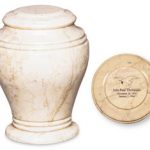 Personalizing products and services has emerged as perhaps the most effective means to help families celebrate the life of their loved one. The individual wishes and needs of cremation families are no different than those who choose traditional services. In fact, it has been cremation families who have inspired the trend towards creating more meaningful funerals by including memorabilia and photo displays with the urn during visitation.
Personalizing products and services has emerged as perhaps the most effective means to help families celebrate the life of their loved one. The individual wishes and needs of cremation families are no different than those who choose traditional services. In fact, it has been cremation families who have inspired the trend towards creating more meaningful funerals by including memorabilia and photo displays with the urn during visitation.
As a result of trying to meet the needs of cremation families, three product trends have grown in popularity. There are theme urns, urns customized with engraving, and miniature keepsake urns.
There are now hundreds of different styled urns available. For those who love flowers there are urns with floral patterns or just a single rose. Book lovers can purchase an urn in the shape of a book. There are even urns for golfers.
For gardeners, Options by Batesville have designed urns with nature themes. These include a sundial, birdbath, and wind chimes that are designed to hold all or a portion of a loved one’s cremated remains and are suitable for use in your own garden. During visitation, they might be displayed with plants and greenery, a trellis or bench to give the appearance of a garden.
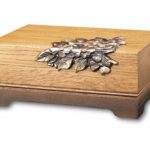 Batesville’s Dolphins urn might be displayed with sand, seashells, a surfboard or even a beach ball to create a setting for someone who loved the ocean. They have even designed an urn for scattering on water. It is a hollow cotton disc with a floral design on the top that holds the cremated remains. The urn will float on the water for two to five minutes before gracefully submerging.
Batesville’s Dolphins urn might be displayed with sand, seashells, a surfboard or even a beach ball to create a setting for someone who loved the ocean. They have even designed an urn for scattering on water. It is a hollow cotton disc with a floral design on the top that holds the cremated remains. The urn will float on the water for two to five minutes before gracefully submerging.
Most urns may also be customized by engraving a loved one’s name, picture or a scene that would have special meaning to the deceased. Through the use of computer-aided graphics, there are very few images that could not be transferred to an urn’s exterior surface.
Keepsake urns, or miniature versions of the full-sized urn, allow individual family members to have their own personal memorial to their loved one. Reasons for their popularity are related to the geographic distance between family members and the location of the interred cremated remains. They are also a viable option when scattering is the final means of disposition.
Keepsakes, which may be used to hold a portion of the cremated remains, are available in many different styles, including sculptures of birds, fish, angels and stags. Miniatures of traditional hardwood urns are also available.
General
Creative displays can help families begin the healing process by encouraging them to remember the things that were important to them about the person and to think of unique and appropriate ways to honour and remember their loved one.